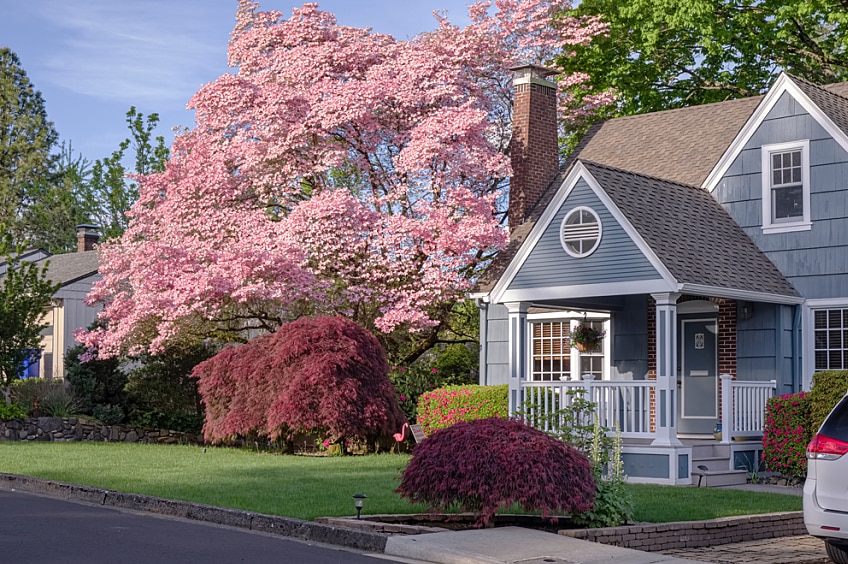As the warmer temperatures of spring arrive, you might be getting out your vacuum, mop, and household cleaners. But the outside of your home likely needs some attention too.
Signs of winter damage often show up once the snow melts and the ground thaws, so now's also the time for outdoor spring cleaning. Proper home maintenance—such as inspecting your roof and other areas of your home that might need repair can help preserve your property.
Here are four tasks to add to your spring cleaning checklist so you can keep your home in great shape.
1. Clear Gutters and Downspouts
Gutters and downspouts can get clogged with leaves and debris over time, especially if you have trees near your home. Clean them out to help prevent water damage—otherwise, the wood trim along your eaves can rot, leaving a gap for critters to crawl in.
Ensure your downspout directs water at least four feet from the house so it doesn't collect along your foundation. If any downspout sections have pulled away, reattach them. It's also a good idea to see if water is leaking through any of the seams. So next time it rains, take a look: if you see leaks, seal the seams with exterior-grade caulking when they're dry.
2. Check Your Roof for Damage
Snow, ice, and wind can take a toll on your roof. So once spring arrives, inspect your roof for any damaged, curling, or missing shingles as well as any leaking flashing. You can start by looking around the perimeter from the ground using binoculars, but it's better to call a professional roofer* to take a closer look.
If you have a fireplace or wood-burning stove, remember to also check the chimney. Look for damage between the joints of bricks and stones.
3. Remove Algae and Moss from Your Roof
If you see discoloration, spots, or streaks on your roof, you might think it's mold, but it can be algae. Algae can grow with moisture on roof surfaces. While it may not damage your shingles, it does detract from the aesthetics of your home.
Moss, which tends to grow on shadier, north-facing sections of the roof, thrives in the crevices between shingles. It can build up over time and cause leaks or other roof problems. Once the moss is established, it acts like a sponge, keeping moisture in. That's why it's important to remove moss as soon as possible.
It's smart to hire a professional to get rid of algae and moss. They can use special equipment to safely access your roof and spray on a mix of water and liquid chlorine bleach, typically 1 cup of bleach with 4 gallons of water. Just avoid having them use a pressure washer to clean off the mixture, as a high-pressure rinse can lead to granule loss on the shingles and degrade the underlying surface, potentially causing your roof system to fail prematurely.
Rain will wash away any residual algae, while moss will loosen over time. However, you might need to have the professional come back to do more than one treatment to kill all the moss. To prevent moss and algae buildup, have an arborist trim tree branches regularly, as this can help protect against leaves or debris landing on your roof.
If algae is an issue on your roof, you may consider installing products that prevent it from growing in the first place, such as shingles with GAF time-release algae-fighting technology
4. Inspect Your Home and Attic for Signs of Water Damage
If your roof is leaking, you'll probably see the resulting damage inside your attic. Look for wet spots on the ceiling, discolored walls, and cracked, flaking drywall. You may also see rusty nails or signs of mold. One way to inspect the remainder of your home is to check the seals on doors and windows. If you see caulk that has hardened or disintegrated you'll want to replace any damaged caulk and screens where needed so no water gets inside your home.
Ensure Your Home Is in Top Shape
Spending an hour or two checking the most vulnerable areas of your house can help prevent expensive repairs down the road. Stay on top of outdoor spring cleaning chores, and you'll be able to get them done efficiently and effectively.
You might also benefit from having your roof inspected for any problems. Professional inspectors can point out factors you didn't consider, helping you extend your roof's lifespan and potentially avoid costly future repairs.
*Contractors enrolled in GAF certification programs are not employees or agents of GAF, and GAF does not control or otherwise supervise these independent businesses. Contractors may receive benefits, such as loyalty rewards points and discounts on marketing tools from GAF for participating in the program and offering GAF enhanced warranties, which require the use of a minimum amount of GAF products.

